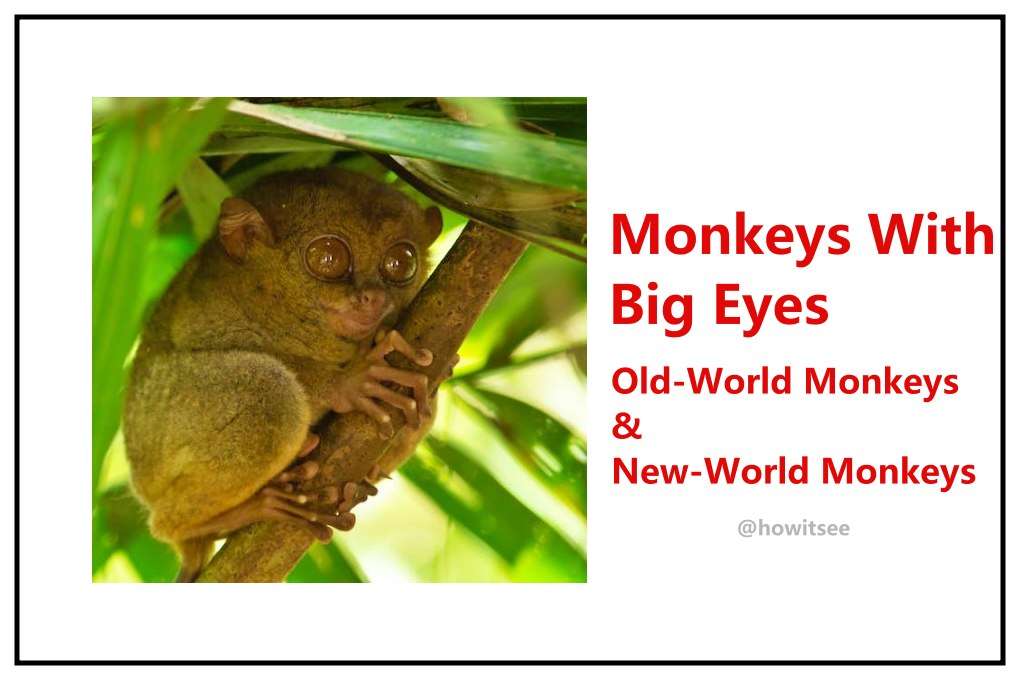In this exclusive article, we will tell you about the Top 10 monkeys with big eyes. In a larger sense, these are different species of primates that are not strictly monkeys but are classified as old-world monkeys and new-world monkeys.
This feature of big eyes in these monkeys evolved as an adaptation for their nocturnal lives and as an aid to maximize their eye sensitivity in low light.
With these adorable, big eyes, they look too cute to be ignored.
Which Primate Has the Largest Eyes?
Tarsiers are known to have the biggest eyes among all primates, and they also have some of the largest eyes in the whole animal kingdom.
Their eye size is a quite large relative to their small body size. Not only this, but they are also the only primates with eye sockets.
Their eyes are so large that when these animals blink, their eyes move independently, just like chameleons.
Top 10 Monkeys With Big Eyes
10) Central American Squirrel Monkey
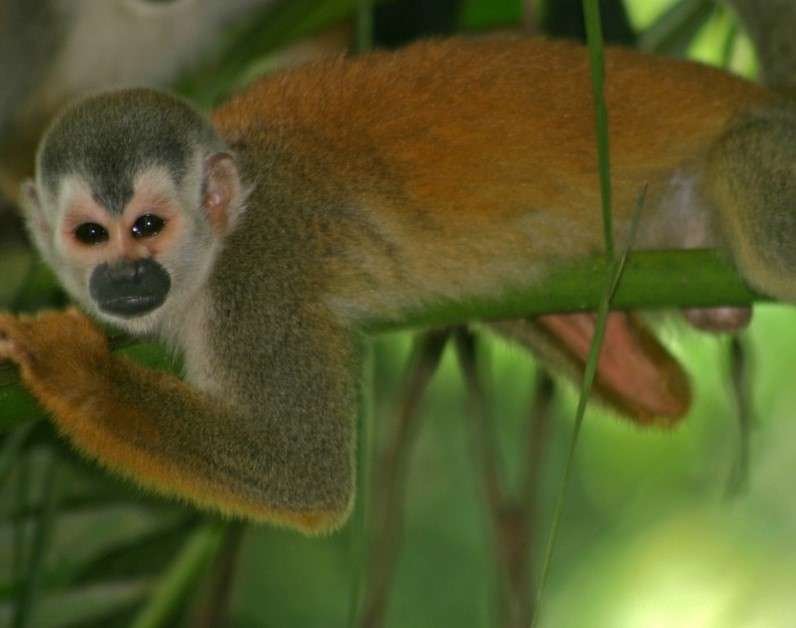
|
Scientific Name |
Saimiri oerstedii |
|
Size |
26.6-29.1 cm (10.5-11.5 in) |
|
Eye Color |
Black |
|
Life Span |
More than 15 years. |
|
Location |
Costa Rica and Panama |
|
Diet |
Fruit, leaves, bark, flowers, and nectar as well as insects and insect larvae, spiders, and small vertebrates, including bats, tree frogs, birds, and lizards. |
Central American squirrel monkeys are diurnal, new-world monkeys that belong to a larger group of squirrel monkeys along with the Ecuadorian squirrel monkey, Humboldt’s squirrel monkey, the bare-eared squirrel monkey, Collins’ squirrel monkey, etc., and share similar features with them, such as big eyes.
They have distinguishing black and white facial masks to illustrate; the big eyes have black rims encircling them and black patches around their mouth and nose, overlaid on their white faces.
They have beautiful golden-orange fur, which is why they are sometimes also referred to as “red-backed squirrel monkeys.” Also, they have long, grey, non-prehensile tails with black on the upper terminal of the tails.
These squirrel monkeys are one of the cleverest monkeys and have large brains compared to their bodies.
9) Golden Snub-nosed Monkey

|
Scientific Name |
Rhinopithecus roxellana |
|
Size |
58-68 cm |
|
Eye Color |
Deep Black |
|
Life Span |
Up to 23 years. |
|
Location |
China |
|
Diet |
lichens, buds, mature leaves, herbs, bark, young leaves, fruits or seeds, and as well as flowers. |
The golden snub-nosed monkey is an arboreal, diurnal, Old world monkey with short stumped noses and nostrils that face forward.
They have big eyes on their pale blue faces that look to be cased in their deep eye sockets.
These monkeys have golden-red to brownish-red body fur that molts all year and thick fur growths on their tails that are as big as their bodies, providing a cushioned resting platform.
These monkeys are highly sociable and are found sleeping in huddles during chilling winter nights to conserve body heat, but the males usually sleep alone.
Whatever the case, the origin of their distinctive noses and strange-looking facial features is still unknown.
8) Northern Greater Galago
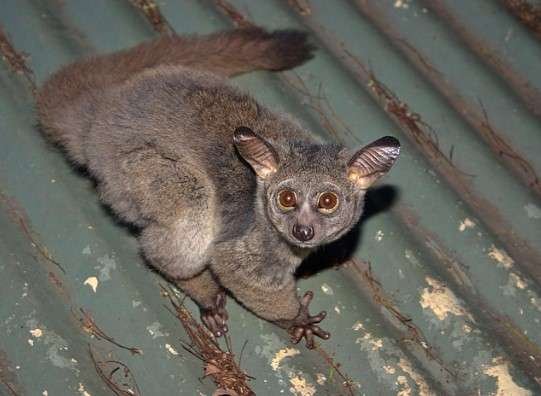
|
Scientific Name |
Otolemur garnettii |
|
Size |
23–34 cm |
|
Eye Color |
Amber or brown |
|
Life Span |
3-4 years |
|
Location |
East Africa |
|
Diet |
Fruits, Insects, and mollusks. |
Northern greater galagos are also known as “bush babies” because they are too adorable and cute like babies and also have big puppy eyes and cry like babies.
They belong to the group of galagos, which are small, nocturnal primates characterized by an elongated tarsus and the ability to fold their large ears.
Other species of galagos with large eyes are Grant’s bushbaby, Somali bushbaby, Senegal bushbaby, etc.
Northern greater galagos have soft, woolly fur colored yellow ventrally and iron grey fur on their backs and limbs, topped with grey-black tails. Not to mention, they are the largest galagos.
7) Giant or Indri Lemur
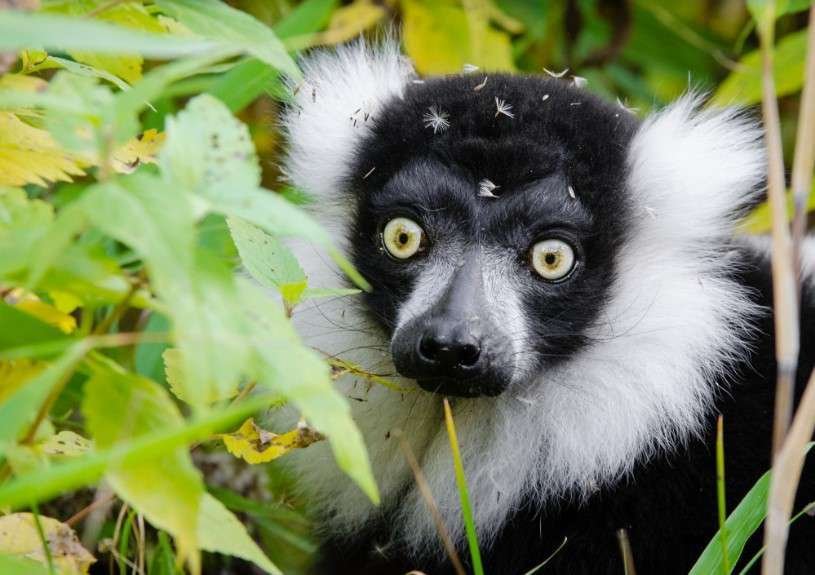
|
Scientific Name |
Indri indri |
|
Size |
64–72 cm (25–28 in) |
|
Eye Color |
Greenish |
|
Life Span |
15-18 years |
|
Location |
Eastern Coast of Madagascar |
|
Diet |
Leaves, seeds, fruits, and flowers. |
Indri is a lemur species that is the largest in comparison to other lemur species. It is commonly called “babakoto.”
They have the largest eyes relative to their body size, and the diameter of their eyes is nearly 4 cm.
Indris have broad, fox-like facial features and monkey-like bodies coupled with long, muscular legs.
They have round, woolly ears framing their black faces and rudimentary tails, unlike other species of lemurs.
Their coloration depends on their geographical range, and southern populations have more whitish markings, whereas northern populations have darker patches on their silky furs.
Another key point is that they are excellent climbers and maintain an upright posture while clinging or climbing vertically.
6) West African Potto
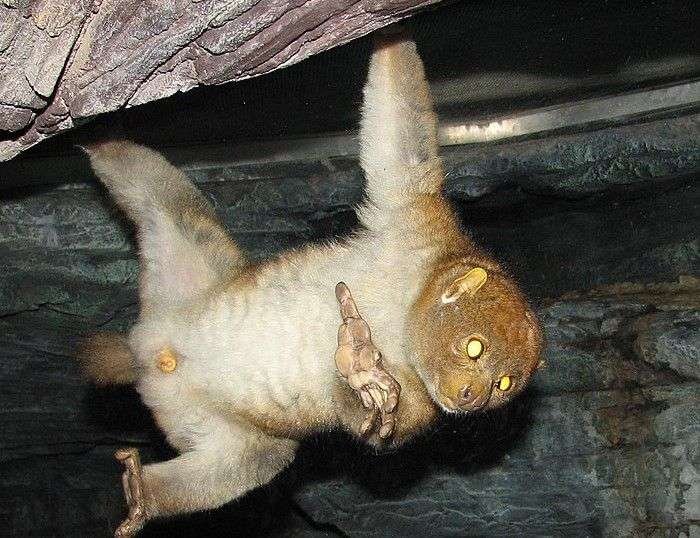
|
Scientific Name |
Perodicticus potto |
|
Size |
30-39 cm |
|
Eye Color |
Blue-black |
|
Life Span |
Up to 26 years. |
|
Location |
West Africa |
|
Diet |
Fruits, tree gums, and insects. |
West African pottos are a species of Potto that are nocturnal and arboreal strepsirrhine primates.
They are solitary, slow-moving primates that are constantly threatened by ongoing, pervasive hunting and habitat loss.
Also, to specify, these are large, slender pottos that have big eyes and short, semi-circled ears on their rounded faces, and their thick, woolly furs are colored a darker brown.
They love to sleep during the day and freeze in place when countered by any potential threat. Also, they lock up their faces and neck-butt their opponents, using their atypical vertebrae to deliver high-powered bites.
Moreover, the compounds present in their saliva have the ability to greatly inflame the wounds.
5) Gray-bellied Night Monkey
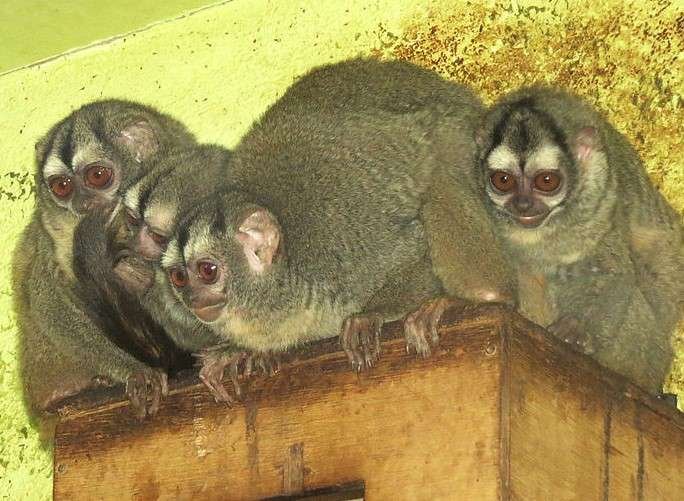
|
Scientific Name |
Aotus lemurinus |
|
Size |
24-37 cm (9-14 in) |
|
Eye Color |
Amber or caramel brown |
|
Life Span |
Up to 30 years. |
|
Location |
South America |
|
Diet |
Fruits, nectar, insects, birds, and small mammals. |
Gray-bellied night monkeys, also known as lemurine owl monkeys or gray-legged monkeys, belong to the category of New World monkeys and are currently facing serious threats because of intense hunting and habitat destruction from overharvesting.
The first feature that attracts viewers towards them is their disproportionately large, shiny, amber-colored eyes, which evolved as a part of their adaptation to living a nocturnal life.
They have dense, wool-like fur with gray-black coloration, and a heart-shaped patch is seen framing their faces.
Additionally, they have three black stripes atop their heads and have notably slim and delicate fingers.
They are the only known species of new-world monkeys that have nocturnal behavior.
4) Panamanian Night Monkey
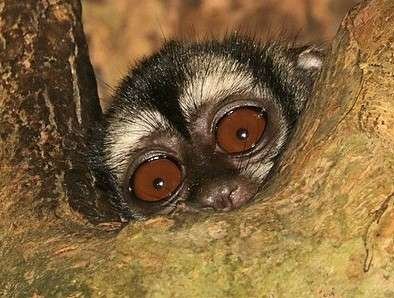
|
Scientific Name |
Aotus zonalis |
|
Size |
12–13 inches (30.5–33 cm) |
|
Eye Color |
Amber or brown |
|
Life Span |
11-12 years |
|
Location |
Panama and Colombia |
|
Diet |
Fruits, leaves, and insects. |
Panamanian night monkeys, also known as Chocoan monkeys, are owl monkeys with large eyes that were previously thought to be a subspecies of the aforementioned grey-bellied night monkeys.
These monkeys are nocturnal, arboreal, social, and strictly monogamous.
They are smaller than other owl monkeys in size, but they have large eyes like them, which is appropriate for their nocturnal behavior.
3) Bengal Slow Loris
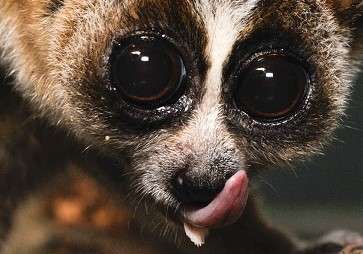
|
Scientific Name |
Nycticebus bengalensis |
|
Size |
26 and 38 cm (10 and 15 in) |
|
Eye Color |
Amber |
|
Life Span |
Up to 20 years |
|
Location |
Indian Subcontinent and Indochina |
|
Diet |
Fruits, insects, gums of trees, snails, and small vertebrates. |
Bengal Slow Loris is a kind of Slow Loris, which are lemur-like primates.
Slow loris consists of many other big-eyed, arboreal, and venomous species, such as Javan slow loris, pygmy slow loris, Sunda slow loris, etc.
Bengal Slow Loris have woolly fur on their bodies that is colored beige-brown. They are very slow movers on account of their slow metabolism and can stay still for hours.
They have the biggest eyes that are typically twice as large in comparison to other slow loris species and are also encircled in darker brown eye patches, along with rounded heads and short ears.
Slow lorises are the only toxic mammals in this world and have venomous secretions from their branchial glands, which are situated on their armpits.
During any threat or potential attack, they lick their armpits, where the venom transfers to their tongue and teeth and subsequently mixes with the bloodstreams of their victims.
2) Groves Dwarf Lemur
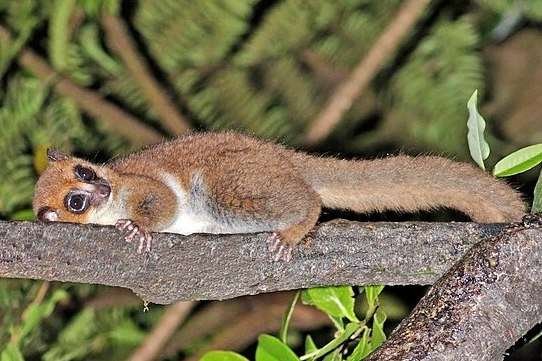
|
Scientific Name |
Cheirogaleus grovesi |
|
Size |
20 cm |
|
Eye Color |
Black |
|
Life Span |
Up to 20 years |
|
Location |
African island of Madagascar |
|
Diet |
Ripe fruits, blossoms, and leaves. |
Groves’ Dwarf Lemurs are a new species of lemur and are tiny primates with large eyes. These lemurs have brownish-black fur and a cute face sporting massive, adorable eyes, just like other species of lemurs.
They have a distinctive white patch on their nose and tiny, fun-sized fingers and thumbs, which aid them in climbing trees and pricking fruits.
They are excellent seed dispersers and are known as “creators of forests” due to their seed dispersal abilities.
1) Philippine Tarsier
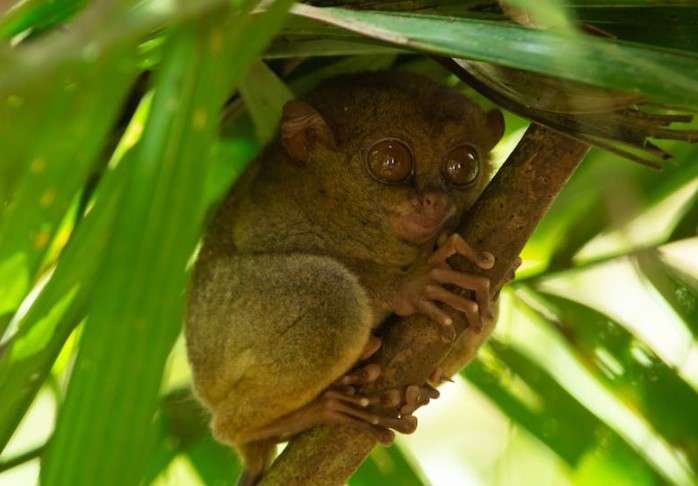
|
Scientific Name |
Carlito syrichta |
|
Size |
85 to 160 mm (3.35 to 6.30 in) |
|
Eye Color |
Beige to light brown |
|
Life Span |
2-12 years |
|
Location |
Philippines |
|
Diet |
Insects, spiders, small vertebrates such as lizards, as well as small crustaceans and birds. |
The Philippine tarsier is one of the species of tarsiers that are leaping primates; they are thought to be an intermediate between monkeys and lemurs and are also commonly known as the world’s smallest monkeys because of their appearance.
They share characteristics with both lemurs and monkeys; they are nocturnal like lemurs and have dry, hair-covered noses like monkeys.
The Philippine tarsiers have enormous eyes that are almost the same size as their brains, and moreover, they have round human-like pupils.
To emphasize this, their large eyes are an adaptation that allows them to see and hunt in the dark by jumping from branch to branch at night.
Additionally, they have the ability to rotate their heads 180 degrees, which aids them in being still and silent during hunting and also in leaping backward on trees with accuracy.
Conclusion:
We hope you enjoyed this article about monkeys with huge eyes. You must be in awe looking at the beautiful pictures of these primates and reading some of the amazing and mind-blowing facts about them.
Also Read:

Hey there! I’ve been the kid who used to love watching all the science stuff and that fascination lead me to choose Zoology as my Major in Graduation. I’m a self-taught writer and spend my time writing scintillating content on animals. I love observing animals behavior and their bond with humans. I want to give my point of view regarding animals i research about. I had done several projects on animals during my graduation and learned their behavior thoroughly.
